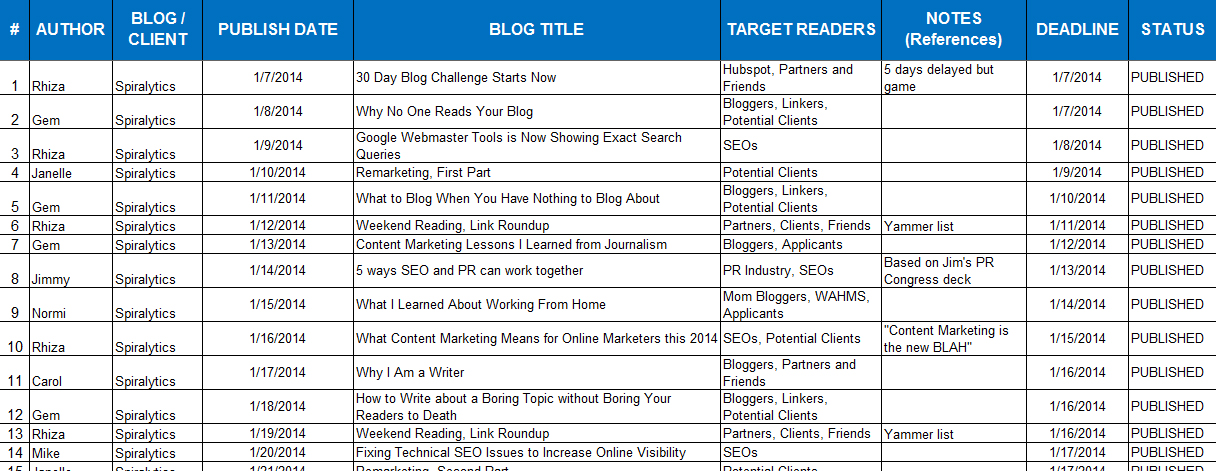In recent years, we’ve seen big brands jump into the content marketing bandwagon and transition into becoming full-blown publishers.
There’s Red Bull and its out-of-this-world (literally) publicity stunts, GoPro and its user-generated extreme sports content, Coca Cola’s lifestyle e-magazine, and General Electric’s love memes. Recently, we heard that Cisco is hiring 200 content marketers.
Mind reels that these big brands are investing a lot of resources to up their content marketing game. How then do the smaller players make Content Marketing work if they don’t have that same amount of resources?
Content Marketing is very doable, whether you’re a big brand, a startup or a small to medium organization. The process is pretty much the same, except of course for the smaller players, the process is scaled down, and the goals should be more targeted in order to maximize results.
We’ve blogged a handful about why corporate blogging is important and the long-term benefits you get from it. Today we’re going to talk about 8 important steps if you want to DIY your content marketing.
1. Set your Goals and KPI
We all agree that our bottom end is sales. But there are several ways to get there so it’s important that you know the specific goals of your strategy. Some of these goals are the following:
- Thought leadership
- Lead Generation
- Brand Awareness
- Social Media Activity
- Customer Retention / Loyalty
- Customer Service
- Customer Acquisition
List down your business goals according to importance and base your content strategy on the most important ones. For example, if your number one KPI is Thought Leadership, you want to invest your assets in expert-level content, topics that are highly technical, and whitepaper material that tackle your specific expertise. You want to publish material that proves you know your craft, and worthy of your target market’s trust.
Chances are, your articles won’t get viral and won’t get as much social media action. However, people who are specifically looking for your services are bound to find your website. As they land on your pages, you have to be able to immediately make an impression.
On the contrary, if you want people to know your brand and to have a wide social media reach, then aim for topics that are shareable and entertaining and easy to understand.
Case in point: General Electric. We all know how highly technical their niche is, however, they have successfully created content that people love sharing in social media (those geeky love memes) even though they have little connection to the product they offer.

Setting goals is a very important part of the process, if not the most important. Knowing your goals allows you to come up with a content marketing strategy that is efficient and relevant.
2. Create Reader Personas
Now that you know what your goals are, it will be easier for you to identify who your readers are.
Be very specific in profiling your persona. How old is your target reader? Is he male or female? What are his interests? What makes him happy? What are his questions and how can you answer them?
With specific target personas in mind, you’ll know how to create content that your reader can relate with. List these down according to priority, and use this as a basis in brainstorming for content ideas.
3. Analyze your Competition
More likely than not, there already are content marketers in your niche. Analyze what works for them—which topics are shared a lot, which sites link back to them. We use Open Site Explorer for a lot of SEO purposes, and also for analyzing websites in the same niche.
Know where to draw the line between analyzing and outright copying. Understanding your competition is necessary, but in content creation, originality and authenticity are of utmost importance. By knowing what works for others, you can set the benchmark for your own purposes and more so, exceed it.
{{cta(’69bc7db2-eaf9-4a85-a552-fcc0c27d8d68′,’justifyright’)}}4. Build a Content Team
Before you begin the content creation process, identify the key people in your company who can contribute in any way. Especially for smaller companies without a dedicated Content Marketing team, it’s important to mobilize your existing employees into contributing whatever they can.
Download The Complete Content Marketing Toolkit for Businesses
Other ways to do this, without hiring too many people at once:
- Scout your specific industry for professional bloggers who are open to contribute on a regular basis. This is not only a good opportunity to network for you, it can also benefit the invited blogger himself.
- Get the higher-ups to contribute ideas, at least once a month. Rand Fishkin had a great presentation about how CEOs can be great marketers, check it out.
- Gamify! Add a bit of friendly competition amongst yourselves as you get everyone on the roster.
- For personal blogs and independent business owners, inviting guest bloggers is a great opportunity.
5. Maintain an Editorial Calendar
Many of us skip this process, but this is very important to make sure that the blog gets updated like clockwork, especially for multiple-author blogs. Without an editorial calendar to guide you, you will most likely take your blog for granted, especially when you feel like you have better things to do. Know how important the Editorial Calendar is and download this sample Editorial Calendar here.

Now, based on your goals, competitive analysis and reader personas, begin listing down topics that you want to write about. If you’re having a difficult time coming up with ideas, ask yourself these questions.
6. Create the Content
Creating content is a separate process on its own, with about 2-3 people involved in the process. Usually, content creation involves 3 parts:
- Writing the Content. Search the web for other similar content, and if there’s any, think of ways to make your article better, and more relevant. Tell stories. Type it as if you’re talking to your audience face to face. Present supporting data. Here are some more resources to help you in the writing process.
- Writing Your First Ever Blog Post (for starters!)
- 15 Great Resources that Will Help You Improve Your Writing
- The Checklist Every Content Writer Needs
- Designing/Sourcing Graphics. It has been proven time and time again that posts with visuals get more attention than posts that don’t, so you want to spend time on this one. If you have someone in your team who’s capable of creating original images, by all means, utilize that asset. Google Images is a good source of traffic, and so is Pinterest, so taking time to create or curate quality images may be beneficial.
- Proofreading, Final Touches, Styling. Have someone check your post for a fresh POV and unbiased opinion. Make the post easy to read and scannable. Utilize header tags to make sub-titles and important keywords bigger.
7. Promote! Amplify!
Content promotion and amplification is a totally different beast altogether. Somewhere I’ve read, Content Marketing is 20% content creation and 80% content promotion. There are millions of blog posts published each day, and with this amount of internet noise, it’s important that you become intentional in bringing your content in front of the right audience.
The gist is, you can’t stop at the publish button. You have to get out there and promote your content intentionally. I think this deserves a lengthier posts. 😉
8. Measure, measure, measure.
Doing Content Marketing without measuring your performance is like walking in the dark. You need to track your performance, especially if you’re DIY-ing your Content Marketing where you have to maximize your effort and your investment.
Here at Spiralytics, we’ve developed a Blog Performance Tool that allows us to track traffic, social media activity, and engagement per post. This helps us in identifying articles that performed better than the others, and the top performing posts for a specific period. This is important because we’re able to build a strategy around what works and what doesn’t, and make more intelligent decisions in choosing topics and types of content.
{{cta(‘4ff38293-29d8-492c-a815-01928793557a’)}}




